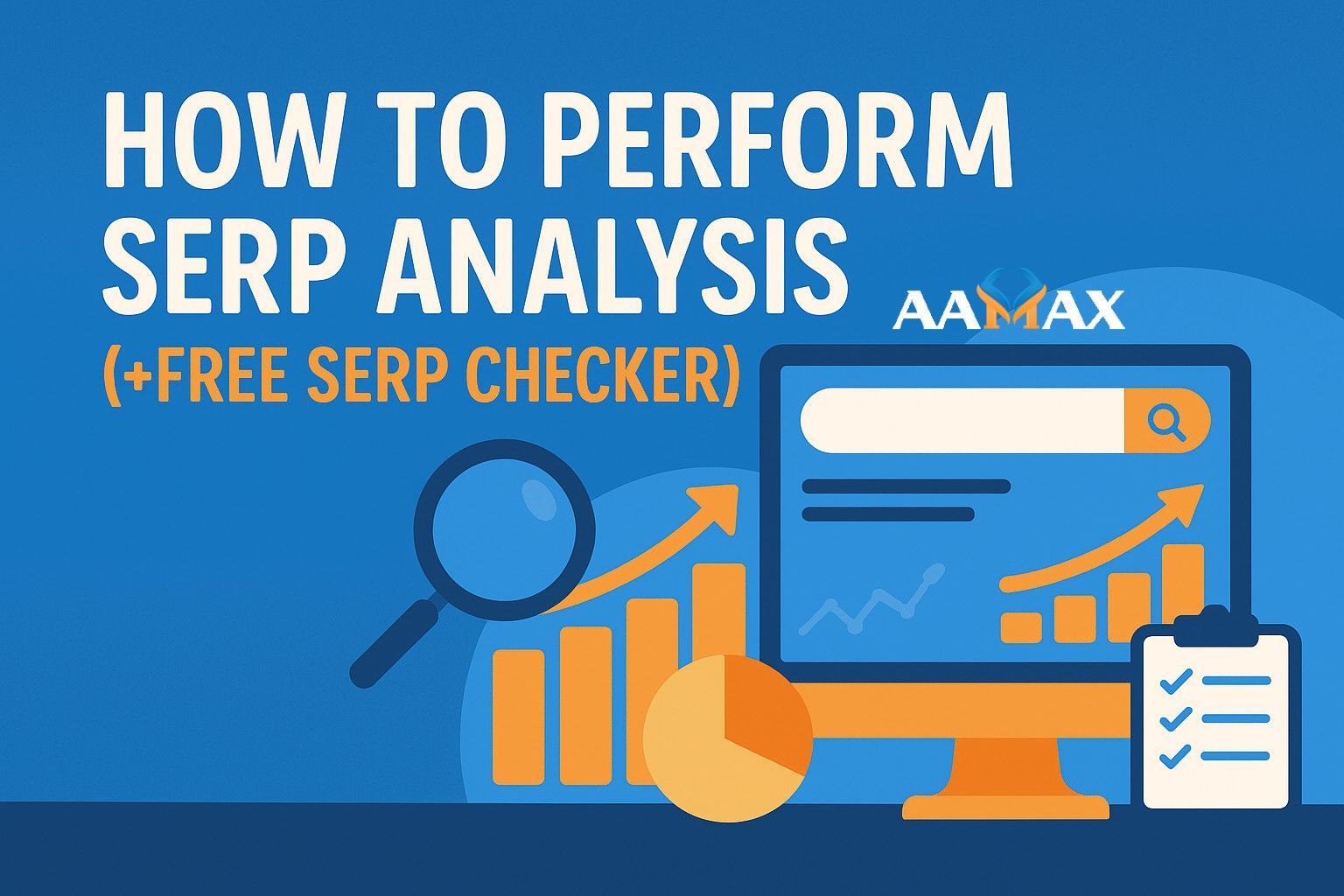
How to Perform SERP Analysis (+Free SERP Checker!)
In today’s hyper-competitive digital landscape, simply publishing content or optimizing for a few keywords is no longer enough. To truly dominate search engine results and outrank your competitors, you need to understand exactly what’s ranking—and why. That’s where SERP analysis comes in.
If you're serious about search engine optimization, SERP analysis should be an integral part of your strategy. This guide will walk you through everything you need to know about performing SERP analysis, introduce you to a free SERP checker, and show you how to use that insight to drive better rankings, traffic, and conversions.
What Is SERP Analysis?
SERP stands for Search Engine Results Page. SERP analysis is the process of examining the top-ranking pages for a particular keyword or search query to determine what content is performing well, why it's ranking, and how you can create something better or more competitive.
It’s not just about identifying the top results—it’s about reverse-engineering Google’s logic. You’re essentially stepping into Google’s shoes to understand what it considers the "best answer" to a user’s question.
Why Is SERP Analysis Important?
Performing SERP analysis helps you:
- Identify user intent behind search queries
- Understand what content format and structure Google prefers
- Discover ranking patterns, such as domain authority or content freshness
- Uncover opportunities for differentiation
- Determine the difficulty of ranking for a specific keyword
This insight is invaluable, especially when you’re deciding whether a keyword is worth targeting or if it needs a different angle.
Key Elements to Analyze in a SERP
Let’s break down what you should be looking at when analyzing a SERP.
1. Search Intent
There are generally four types of search intent:
- Informational: Looking for information (e.g., "how to do SERP analysis")
- Navigational: Looking for a specific website (e.g., "YouTube login")
- Transactional: Ready to buy or sign up (e.g., "buy noise-canceling headphones")
- Commercial investigation: Comparing before purchase (e.g., "best budget smartphones")
The type of intent influences the kind of content that will rank. For example, if the top results for “best CRM software” are all listicles, writing a product page for your CRM tool might not be enough.
2. Content Format and Type
Ask yourself:
- Are most results blog posts, videos, product pages, or landing pages?
- Are they long-form or short-form?
- Do they include visuals, tables, or infographics?
Matching the format increases your chances of ranking because you’re aligning with what Google already favors for that keyword.
3. Page Titles and Meta Descriptions
Review the titles and meta descriptions to:
- Understand the value proposition competitors are using
- Identify common keyword variations
- See what hooks or CTAs are being used to encourage clicks
You’ll often find trends you can adapt or improve upon.
4. Domain Authority and Brand Power
If the top results are dominated by mega brands like HubSpot, Forbes, or Wikipedia, ranking organically will be tough without a strong domain.
However, if you see lesser-known websites ranking, that’s your window of opportunity.
Use free tools like Moz’s Domain Authority Checker or Ahrefs’ Website Authority Checker to estimate how competitive the SERP is.
5. Backlink Profiles
Backlinks are still a major ranking factor. Use free tools like Ubersuggest, Ahrefs (free version), or SEO services Review Tools to check:
- How many backlinks do the top results have?
- What is the quality of those backlinks?
- Are they from relevant or high-authority sites?
This helps you gauge how much link-building effort might be needed to compete.
6. On-Page SEO Elements
Click into each top-ranking page and assess:
- H1, H2, H3 structure
- Keyword placement
- Use of images and alt-text
- Internal linking strategy
- Page load speed
- Mobile responsiveness
Google rewards well-optimized pages that also offer great user experience.
7. Featured Snippets, Knowledge Panels, and Other SERP Features
SERPs are no longer just 10 blue links. Look for:
- Featured snippets
- People also ask boxes
- Image carousels
- Video results
- Local packs
- Shopping ads
These features show how Google is interpreting the intent and which rich results you might be able to target.
Step-by-Step Guide to Performing a SERP Analysis
Here’s how to perform a complete SERP analysis in a practical, repeatable way.
Step 1: Choose Your Target Keyword
Start with a keyword you want to rank for. Use a keyword research tool like:
- Google Keyword Planner
- Ubersuggest
- Ahrefs
- SEMrush
- Moz Keyword Explorer
Make sure the keyword has decent search volume and is relevant to your content or offer.
Step 2: Use a Free SERP Checker
Free SERP analysis tools include:
- SERP Checker by Mangools (free trial)
- Ubersuggest SERP Analysis
- Ahrefs SERP Checker (free version)
- SEOquake Chrome Extension
- MozBar
Paste your keyword into one of these tools to see:
- The top 10 search results
- Their domain and page authority
- Backlink data
- Estimated traffic
- Page-level metrics
This gives you a snapshot of what you’re up against.
Step 3: Analyze the Top 10 Results
Visit each top result and make notes on:
- Headline (H1) and title tag usage
- Content format and tone (is it casual, formal, technical?)
- Keyword usage (including long-tail and semantic variations)
- Page structure (use of subheadings, media, bullet points)
- Engagement features (comments, share buttons, CTAs)
This will help you build a content blueprint for your own page.
Step 4: Find Gaps and Opportunities
Look for:
- Unanswered questions in competitor content
- Poor formatting or weak UX
- Lack of visual elements
- Thin content (especially on older ranking pages)
You can also check Google’s “People also ask” section and Related Searches at the bottom of the page for additional keywords and subtopics to cover.
Step 5: Create a Better Piece of Content
Now that you understand the SERP landscape, create content that:
- Matches or improves on the top format
- Includes all the essential keywords and questions
- Offers unique value or a different perspective
- Optimizes for both users and search engines
The goal is to build the best page on the internet for that keyword.
Step 6: Track Your Rankings Over Time
Use free tools like:
- Google Search Console
- Ubersuggest rank tracker (free for a limited number of keywords)
- SERPROBOT (limited free checks)
- SEO PowerSuite Rank Tracker
These tools help you monitor how your content is performing in the SERPs post-publishing.
Tools to Help With SERP Analysis
Here’s a list of free and freemium tools that are especially helpful:
| Tool | Key Features | Price | |------|--------------|-------| | Ubersuggest | Keyword data, SERP overview, backlink analysis | Free & Paid | | Ahrefs Free Tools | SERP checker, keyword rank checker | Free | | MozBar | Domain & page authority checker | Free | | SEOquake | On-page audit, SERP overlay | Free | | Google Search Console | Keyword tracking, performance insights | Free | | SERP Robot | Rank checking by keyword & domain | Free | | Keywords Everywhere | On-SERP keyword metrics | Freemium |
Common Mistakes to Avoid During SERP Analysis
- Ignoring user intent and creating the wrong type of content
- Relying solely on tools without manually reviewing actual pages
- Failing to track rich features like snippets and local packs
- Assuming keyword difficulty is only about volume and backlinks
- Not updating your analysis over time (SERPs evolve!)
Final Thoughts: SERP Analysis = SEO Superpower
SERP analysis is one of the most underused yet powerful SEO tactics. By deeply understanding what currently ranks and why, you gain a roadmap to outperform competitors—not by guessing, but by strategic insight.
Whether you’re an SEO newbie or a content marketer, learning how to reverse-engineer the SERPs will sharpen your decision-making, refine your strategy, and increase.
Want help optimizing your website, climbing the SERPs, and building a digital presence that delivers real ROI? Hire AAMAX — a full-service digital marketing company offering expert Web Development, SEO, and Digital Marketing services. With a team of seasoned professionals and a results-driven approach, AAMAX can help you not just analyze, but conquer the SERPs.







